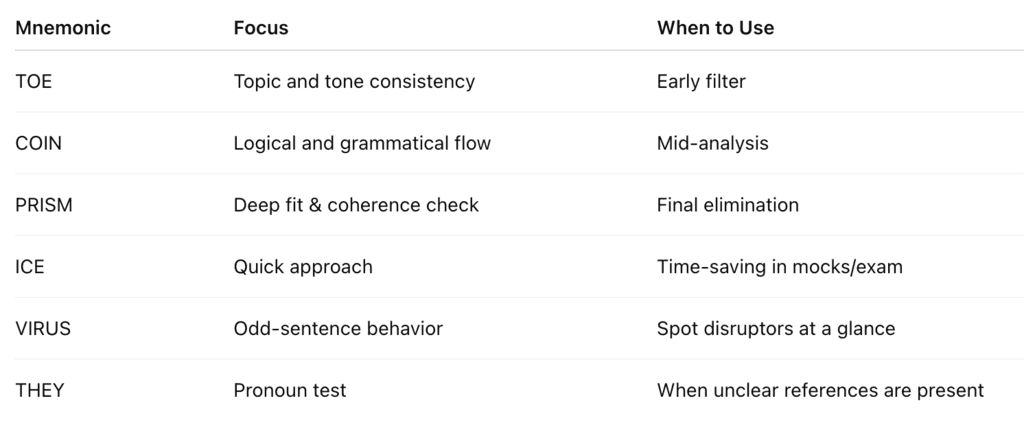Mnemonics & Strategies: Odd Sentence Out | Verbal Ability & Reading Comprehension (VARC) - CAT PDF Download
| Table of contents |

|
| Introduction |

|
| Core Mnemonics to Crack It |

|
| Mnemonics for Specific Traps |

|
| Example Using PRISM & TOE |

|
| Final Takeaway |

|
Introduction
In this question type, you're given 4–5 jumbled sentences. While most form a coherent paragraph, one doesn't fit—your task is to find and eliminate that Odd One Out.

Core Mnemonics to Crack It
1. TOPIC Test → “TOE” Mnemonic
Check if all sentences revolve around the same Topic, Object, or Emotion. If one sentence doesn’t match even one toe in this, it’s probably out of step.
T – Topic mismatch: Does this talk about something entirely different?
O – Object focus shift: Is the object/subject of action inconsistent?
E – Emotion/tone mismatch: Is the tone too casual, dramatic, or technical compared to others?
Use: If the sentence is not “putting its TOE in the same stream,” it doesn’t belong.
2. COIN Test → Connectors, Order, Ideas, Naming
This helps identify logical and grammatical links:
C – Connectors: Words like “however,” “moreover,” “thus” require logical buildup.
O – Order disruption: Does this sentence break the natural flow of idea development?
I – Idea mismatch: Is the central idea or theme unrelated?
N – Naming confusion: Does it refer to something (a person, event, theory) not introduced?
Use: Like a COIN tossed in the air, does the sentence land right in the theme? If not—it’s fake currency.
3. PRISM Test → Filters for Logical Fit
Just as a prism breaks light into components, this mnemonic filters sentence flow:
P – Pronouns: Are “he,” “it,” or “this” referring back clearly?
R – Repetition or Reference: Is the sentence repeating something or introducing a disjointed reference?
I – Introductory or Isolated: Is this trying to start a new idea while others continue one?
S – Support Check: Does it support a claim already made, or does it float alone?
M – Mismatch in detail or scale: Too specific? Too general? Doesn’t match the rest?
4. ICE Rule – Identify, Connect, Eliminate
I – Identify the core idea of the majority
C – Connect supporting sentences around it
E – Eliminate the one that floats away
Mnemonics for Specific Traps
THEY Trap (Pronoun Pitfall)
Whenever you see they, it, these, such, ask:
Who are they?
What is it?
If there’s no clear link, odds are high it’s an odd one out.
VIRUS Trap (Disruptor Sentence)
Odd sentences often behave like a VIRUS in a healthy paragraph.
V – Vague idea
I – Introduces a new subject
R – Reverses the flow (e.g., contradicts)
U – Unnecessary detail
S – Stands alone
If a sentence carries this viral behaviour, isolate and eject.
Example Using PRISM & TOE
Sentences:
A. Meditation is known to improve mental well-being and focus.
B. Many students report better memory after a few weeks of mindfulness practice.
C. Yoga involves physical postures and breathing techniques.
D. Research suggests meditation alters brain structure.
E. Mindfulness helps reduce stress and anxiety levels.
Analysis:
A, B, D, and E are all about meditation/mindfulness.
C introduces Yoga, which is related but a different concept.
Using PRISM:
P (Pronouns): No confusion
R (Reference): “Yoga” is a new reference
I (Introductory): Yes, “Yoga involves…” feels like a new topic
S (Support): Doesn’t support any earlier sentence
M (Mismatch): Yes, detail is physical, while others are mental
Answer: C is the odd sentence out.
Final Takeaway

|
111 videos|450 docs|90 tests
|
FAQs on Mnemonics & Strategies: Odd Sentence Out - Verbal Ability & Reading Comprehension (VARC) - CAT
| 1. What are core mnemonics and how can they help in exams? |  |
| 2. Can you provide examples of specific mnemonics for common traps in exams? |  |
| 3. How can the PRISM and TOE methods be utilized in exam preparation? |  |
| 4. What strategies can be employed to tackle the 'Odd Sentence Out' type of questions in exams? |  |
| 5. Why is it important to have a final takeaway or summary in exam preparation? |  |















